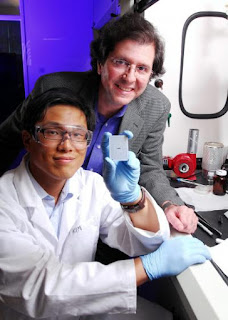Because of its high dielectric properties, barium titanate has long been of interest for use in capacitors, but until recently materials scientists had been unable to produce good dispersion of the material within a polymer matrix. By using tailored organic phosphonic acids to encapsulate and modify the surface of the nanoparticles, researchers at the Georgia Institute of Technology’s Center for Organic Photonics and Electronics were able to overcome the particle dispersion problem to create uniform nanocomposites.
The new nanocomposite materials have been tested at frequencies of up to one megahertz, and Perry says operation at even higher frequencies may be possible. Though the new materials could have commercial application without further improvement, their most important contribution may be in demonstrating the new encapsulation technique – which could have broad applications in other nanocomposite materials.
"This work opens a door to effectively exploit this type of particle in nanocomposites using the coating technology we have demonstrated," explained Perry. "There are many ways we can envision making advances beyond what we’ve done already."
The results were reported in the April 2007 edition (Vol. 19, issue 7) of the journal Advanced Materials. The research was supported by the Office of Naval Research and the National Science Foundation. Georgia Tech has filed a patent application on the nanoparticle encapsulation technique.
Because of their ability to store and rapidly discharge electrical energy, capacitors are used in a variety of consumer products such as computers and cellular telephones. And because of the increasing demands for electrical energy to power vehicles and new equipment, they also have important military applications.
"Phosphonic acids bind very well to barium titanate and to other related metal oxides," Perry said. "The choice of that material and ligands were very effective in allowing us to take the tailored phosphonic acids, put them onto the barium titanate, and then with the correct solution processing, to incorporate them into polymer systems. This allowed us to provide good compatibility with the polymer hosts – and thus very good dispersion as evidenced by a three- to four-fold decrease in the average aggregate size."
Though large crystals of barium titanate could also provide a high dielectric constant, they generally do not provide adequate resistance to breakdown – and their formation and growth can be complex and require high temperatures. Composites provide the necessary electrical properties, along with the advantages of solution-based processing techniques.
"One of the big benefits of using a polymer nanocomposite approach is that you combine particles of a material that provide desired properties in a matrix that has the benefits of easy processing," Perry explained.
Though the new materials may already offer enough of an advantage to justify commercializing, Perry believes there are additional opportunities for boosting their performance. The research team also wants to scale up production to make larger samples – now produced in two-inch by three-inch films – available to other researchers who may wish to develop additional applications.
Perry and Marder are working with Bernard Kippelen, a professor in the Georgia Tech School of Electrical and Computer Engineering, on the use of these new nanocomposites in organic thin-film transistors in which solution-based techniques are used to fabricate inexpensive electronic components.
"Beyond capacitors, there are many areas where high dielectric materials are important, such as field-effect transistors, displays and other electronic devices," Perry added. "With our material, we can provide a high dielectric layer that can be incorporated into those types of applications." ###
In addition to those already mentioned, the research team included Philseok Kim, Simon Jones, Peter Hotchkiss and Joshua Haddock.
Research News & Publications Office, Georgia Institute of Technology, 75 Fifth Street, N.W., Suite 100, Atlanta, Georgia 30308 USA
Technical Contact: Joe Perry (404-385-6046); E-mail: (joe.perry@gatech.edu). Writer: John Toon
Contact: John Toon jtoon@gatech.edu 404-894-6986 Georgia Institute of Technology Research News
Technorati Tags: nanofibers or Nanoscientists and Nano or Nanotechnology and nanoparticles or Nanotech and nanotubes or nanochemistry and nanoscale or nanowires and Nanocantilevers or nanometrology and capacitors or barium titanate and Georgia Institute of Technology or organic phosphonic acids

















No comments:
Post a Comment